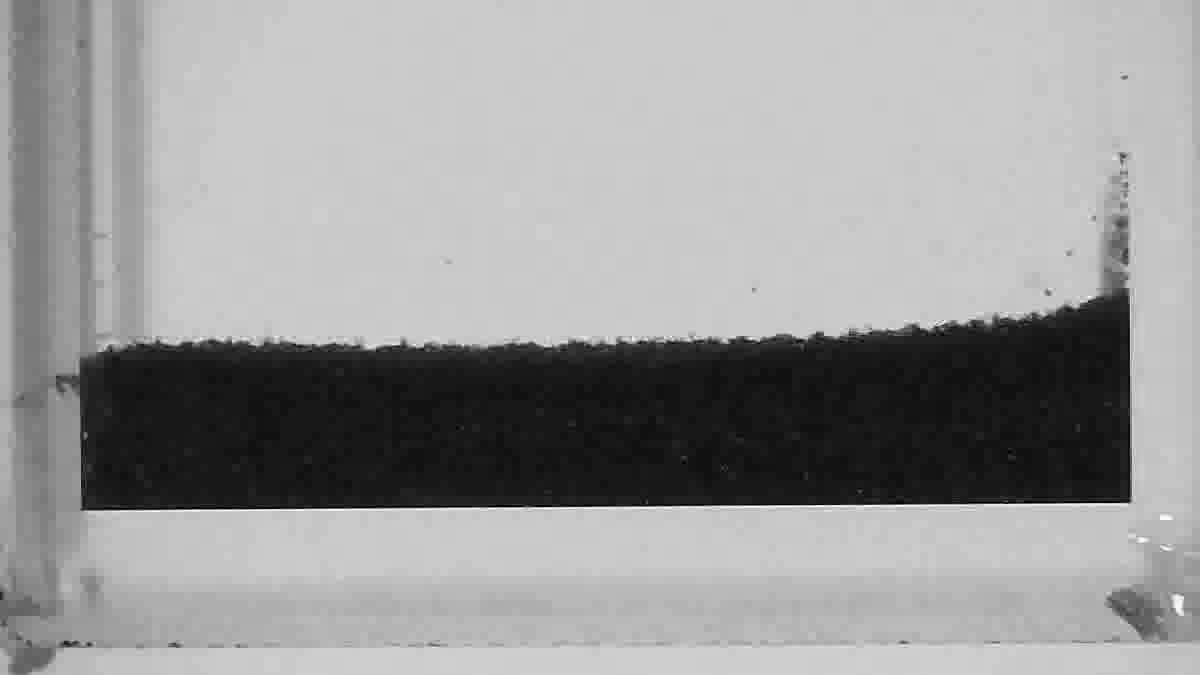Lehigh University researchers make sand that flows uphill

Engineering researchers at Lehigh University have discovered that sand can actually flow uphill.
The team’s findings were published today in the journal Nature Communications. A corresponding video shows what happens when torque and an attractive force is applied to each grain—the grains flow uphill, up walls, and up and down stairs. (Two clips, GIF1 and GIF2, also show the uphill granular flow.)
“After using equations that describe the flow of granular materials,” says James Gilchrist, the Ruth H. and Sam Madrid Professor of Chemical and Biomolecular Engineering in Lehigh’s P.C. Rossin College of Engineering and Applied Science and one of the authors of the paper, “we were able to conclusively show that these particles were indeed moving like a granular material, except they were flowing uphill.”
The researchers say the highly unusual discovery could unlock many more lines of inquiry that could lead to a vast range of applications, from healthcare to material transport and agriculture.
The paper’s lead author, Dr. Samuel Wilson-Whitford, a former postdoctoral research associate in Gilchrist’s Laboratory of Particle Mixing and Self-Organization, captured the movement entirely by serendipity in the course of his research into microencapsulation. When he rotated a magnet beneath a vial of iron oxide-coated polymer particles called microrollers, the grains began to heap uphill.
Video: Uphill granular flow of microrobotic microrollers
Wilson-Whitford and Gilchrist began studying how the material reacted to the magnet under different conditions. When they poured the microrollers without activating them with the magnet, they flowed downhill. But when they applied torque using the magnets, each particle began to rotate, creating temporary doublets that quickly formed and broke up. The result, says Gilchrist, is cohesion that generates a negative angle of repose due to a negative coefficient of friction.
“Up until now, no one would have used these terms,” he says. “They didn’t exist. But to understand how these grains are flowing uphill, we calculated what the stresses are that cause them to move in that direction. If you have a negative angle of repose, then you must have cohesion to give a negative coefficient of friction. These granular flow equations were never derived to consider these things, but after calculating it, what came out is an apparent coefficient of friction that is negative.”
Increasing the magnetic force increases the cohesion, which gives the grains more traction and the ability to move faster. The collective motion of all those grains, and their ability to stick to each other, allows a pile of sand particles to essentially work together to do counterintuitive things—like flow up walls, and climb stairs. The team is now using a laser cutter to build tiny staircases, and is taking videos of the material ascending one side and descending the other. A single microroller couldn’t overcome the height of each step, says Gilchrist. But working together, they can.
“This first paper just focuses on how the material flows uphill, but our next several papers will look at applications, and part of that exploration is answering the question, can these microrollers climb obstacles? And the answer is yes.”
Potential applications could be far ranging. The microrollers could be used to mix things, segregate materials, or move objects. And because these researchers have discovered a new way to think about how the particles essentially swarm and work collectively, future uses could be in microrobotics, which in turn could have applications in healthcare. Gilchrist recently submitted a paper exploring their use on soil as a means of delivering nutrients through a porous material.
“We’re studying these particles to death,” he says, “experimenting with different rotation rates, and different amounts of magnetic force to better understand their collective motion. I basically know the titles of the next 14 papers we’re going to publish.”
Associated funders include The John Hopkins University Applied Physics Laboratories, the National Science Foundation (1931681), the McClurg Endowment Faculty Development Fund of the Department of Chemical and Biomolecular Engineering at Lehigh University. Equipment in Lehigh’s Institute for Functional Materials and Devices (I-FMD) was used in the research.
Related Links:
- Nature Communications: “Microrollers flow uphill as granular media”
- Rossin College Faculty Profile: James F. Gilchrist
- Lehigh University: Laboratory for Particle Mixing and Self-Organization
- LinkedIn: Dr. Samuel Wilson-Whitford
- Institute for Functional Materials and Devices
Journal: Nature Communications
DOI: 10.1038/s41467-023-41327-1
Article Title: Microrollers flow uphill as granular media
Article Publication Date: 20-Sep-2023
Media Contact
Katie Kackenmeister
P.C. Rossin College of Engineering and Applied Science, Lehigh University
engineering@lehigh.edu
@lehighengineers
Media Contact
All latest news from the category: Materials Sciences
Materials management deals with the research, development, manufacturing and processing of raw and industrial materials. Key aspects here are biological and medical issues, which play an increasingly important role in this field.
innovations-report offers in-depth articles related to the development and application of materials and the structure and properties of new materials.
Newest articles

First-of-its-kind study uses remote sensing to monitor plastic debris in rivers and lakes
Remote sensing creates a cost-effective solution to monitoring plastic pollution. A first-of-its-kind study from researchers at the University of Minnesota Twin Cities shows how remote sensing can help monitor and…

Laser-based artificial neuron mimics nerve cell functions at lightning speed
With a processing speed a billion times faster than nature, chip-based laser neuron could help advance AI tasks such as pattern recognition and sequence prediction. Researchers have developed a laser-based…

Optimising the processing of plastic waste
Just one look in the yellow bin reveals a colourful jumble of different types of plastic. However, the purer and more uniform plastic waste is, the easier it is to…



